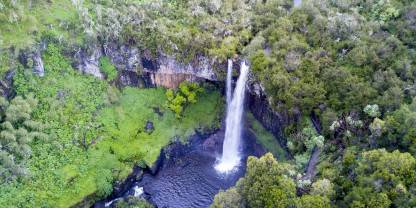Aberdare National Park is a birder’s paradise, with around 300 species recorded, including many rarities. Striking forest birds that might be seen at the tree hotels include Hartlaub’s turaco, silvery-cheeked hornbill and cinnamon-chested bee-eater. Birding highlights at higher altitudes include the localized Jackson’s spurfowl, handsome augur buzzard and Aberdare cisticola. A variety of nectar-feeding sunbirds, including the very localized and colorful scarlet-tufted malachite sunbird, are attracted to flowering plants.
Birding Specials Treats for Avid Birders
(E) endemic = only lives in Kenya(NE) near-endemic = lives in Kenya and neighboring countries
- Aberdare cisticola (E)
- Abyssinian crimsonwing
- African black duck
- African goshawk
- African green pigeon
- African paradise flycatcher
- African thrush
- African yellow warbler
- Augur buzzard
- Ayres’s hawk-eagle
- Bar-tailed trogon
- Black-fronted bush-shrike
- Bronzy sunbird
- Cinnamon-chested bee-eater
- Crowned eagle
- Doherty’s bush-shrike
- Golden-winged sunbird
- Hartlaub’s turaco
- Hunter’s cisticola
- Jackson’s spurfowl (NE)
- Montagu’s harrier
- Montane white-eye
- Moorland chat
- Moorland francolin
- Mountain buzzard
- Mountain wagtail
- Moustached green tinkerbird
- Narina trogon
- Olive ibis
- Rufous-chested sparrowhawk
- Scarlet-tufted malachite sunbird
- Sharpe’s longclaw (NE)
- Silvery-cheeked hornbill
- Speke’s weaver
- Streaky seedeater
- Tacazze sunbird
- Tambourine dove
- White-eyed slaty flycatcher
- White-headed wood-hoopoe
Best Time for Bird Watching
Aberdare offers good bird watching year-round, but November to April is when from Europe and North Africa are present. This partly coincides with the Wet season (October to May), when many species can be seen in breeding plumage. Most forest and moorland specials are throughout the year, so the drier months (June to September and December to February) offer a good combination of rewarding bird watching and relatively agreeable weather.

